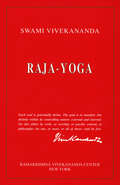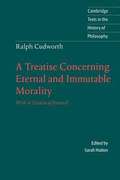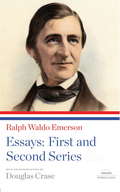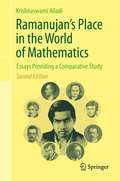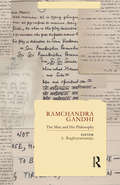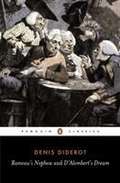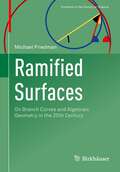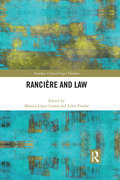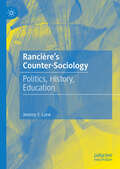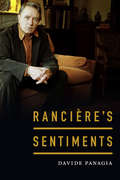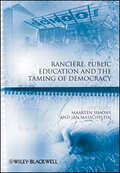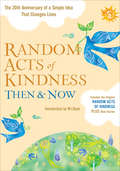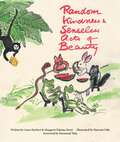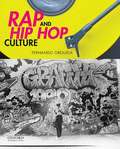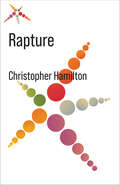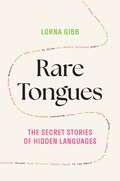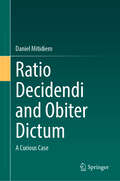- Table View
- List View
Raja-Yoga
by Swami Vivekananda Swami NikhilanandaRaja-Yoga describes the methods of spiritual concentration, meditation, and psychic development.
Ralph Cudworth: A Treatise Concerning Eternal And Immutable Morality - With A Treatise Of Freewill
by Karl Ameriks Desmond M. Clarke Ralph Cudworth Sarah HuttonRalph Cudworth (1617-1688) deserves recognition as one of the most important English seventeenth-century philosophers after Hobbes and Locke. In opposition to Hobbes, Cudworth proposes an innatist theory of knowledge which may be contrasted with the empirical position of his younger contemporary Locke, and in moral philosophy he anticipates the ethical rationalists of the eighteenth century. A Treatise Concerning Eternal and Immutable Morality is his most important work, and this volume makes it available, together with his shorter Treatise of Freewill, with a historical introduction, a chronology of his life, and an essay on further reading.
Ralph Waldo Emerson: First and Second Series
by Ralph Waldo Emerson Douglas Crase"Emerson's prose is his triumph, both as eloquence and as insight. After Shakespeare, it matches anything else in the language." -Harold BloomHere are Ralph Waldo Emerson's classic essays, including the exhortation to "Self-Reliance," the embattled realizations of "Circles" and "Experience," and the groundbreaking achievement of "Nature." Our most eloquent champion of individualism, Emerson acknowledges at the same time the countervailing pressures of society in American life. Even as he extols what he calls "the great and crescive self," he dramatizes and records its vicissitudes. Also gathered here are his wide-ranging discourses on history, art, politics, friendship, love, and much more. For almost thirty years, The Library of America has presented America's best and most significant writing in acclaimed hardcover editions. Now, a new series, Library of America Paperback Classics, offers attractive and affordable books that bring The Library of America's authoritative texts within easy reach of every reader. Each book features an introductory essay by one of a leading writer, as well as a detailed chronology of the author's life and career, an essay on the choice and history of the text, and notes. The contents of this Paperback Classic are drawn from Ralph Waldo Emerson: Essays and Lectures, volume number 15 in the Library of America series. It is joined in the series by three companion volumes, gathering Emerson's poems, translations, and selections from his journals.From the Trade Paperback edition.
Ramanujan's Place in the World of Mathematics: Essays Providing a Comparative Study
by Krishnaswami AlladiThe First Edition of the book is a collection of articles, all by the author, on the Indian mathematical genius Srinivasa Ramanujan as well as on some of the greatest mathematicians in history whose life and works have things in common with Ramanujan. It presents a unique comparative study of Ramanujan’s spectacular discoveries and remarkable life with the monumental contributions of various mathematical luminaries, some of whom, like Ramanujan, overcame great difficulties in life. Also, among the articles are reviews of three important books on Ramanujan’s mathematics and life. In addition, some aspects of Ramanujan’s contributions, such as his remarkable formulae for the number pi, his path-breaking work in the theory of partitions, and his fundamental observations on quadratic forms, are discussed. Finally, the book describes various current efforts to ensure that the legacy of Ramanujan will be preserved and continue to thrive in the future.This Second Edition is an expanded version of the first with six more articles by the author. Of note is the inclusion of a detailed review of the movie The Man Who Knew Infinity, a description of the fundamental work of the SASTRA Ramanujan Prize Winners, and an account of the Royal Society Conference to honour Ramanujan’s legacy on the centenary of his election as FRS.
Ramchandra Gandhi: The Man and His Philosophy
by A. RaghuramarajuRamchandra Gandhi, famous for his rich and varied interests, left behind a large corpus of writings, both philosophical and non-philosophical. Introducing the readers to the creative Indian philosopher, this volume highlights the principal thrust of his works, critically locates them within the larger political, philosophical, literary and socio-cultural context, and accounts for his lasting influence. For the first time, essays on Ramchandra Gandhi’s earlier works and later writings have been brought together to take stock of his contribution to contemporary Indian thought as a whole. Written by philosophers as well as those belonging to literature and the social sciences, the essays record his experimental ventures both in form and content, and shed light on key themes in language, communication, religion, aesthetics, spirituality, consciousness, self, knowledge, politics, ethics, and non-violence. The book will appeal to those in philosophy, political science, history, sociology, literature, and Gandhian studies.
Rameau's Nephew and D'Alembert's Dream: Translated with Introductions by Leonard Tancock
by Denis DiderotIn Rameau's Nephew, the eccentric and foolish nephew of the great composer Jean-Philippe Rameau meets Diderot by chance, and the two embark on a hilarious consideration of society, music, literature, politics, morality and philosophy.
Ramified Natural Theology in Science and Religion: Moving Forward from Natural Theology (Routledge Science and Religion Series)
by Rodney HolderThis book offers a rationale for a new ‘ramified natural theology’ that is in dialogue with both science and historical-critical study of the Bible. Traditionally, knowledge of God has been seen to come from two sources, nature and revelation. However, a rigid separation between these sources cannot be maintained, since what purports to be revelation cannot be accepted without qualification: rational argument is needed to infer both the existence of God from nature and the particular truth claims of the Christian faith from the Bible. Hence the distinction between ‘bare natural theology’ and ‘ramified natural theology.’ The book begins with bare natural theology as background to its main focus on ramified natural theology. Bayesian confirmation theory is utilised to evaluate competing hypotheses in both cases, in a similar manner to that by which competing hypotheses in science can be evaluated on the basis of empirical data. In this way a case is built up for the rationality of a Christian theist worldview. Addressing issues of science, theology and revelation in a new framework, this book will be of keen interest to scholars working in Religion and Science, Natural Theology, Philosophy of Religion, Biblical Studies, Systematic Theology, and Science and Culture.
Ramified Surfaces: On Branch Curves and Algebraic Geometry in the 20th Century (Frontiers in the History of Science)
by Michael FriedmanThe book offers an extensive study on the convoluted history of the research of algebraic surfaces, focusing for the first time on one of its characterizing curves: the branch curve. Starting with separate beginnings during the 19th century with descriptive geometry as well as knot theory, the book focuses on the 20th century, covering the rise of the Italian school of algebraic geometry between the 1900s till the 1930s (with Federigo Enriques, Oscar Zariski and Beniamino Segre, among others), the decline of its classical approach during the 1940s and the 1950s (with Oscar Chisini and his students), and the emergence of new approaches with Boris Moishezon’s program of braid monodromy factorization.By focusing on how the research on one specific curve changed during the 20th century, the author provides insights concerning the dynamics of epistemic objects and configurations of mathematical research. It is in this sense that the book offers to take the branch curve as a cross-section through the history of algebraic geometry of the 20th century, considering this curve as an intersection of several research approaches and methods. Researchers in the history of science and of mathematics as well as mathematicians will certainly find this book interesting and appealing, contributing to the growing research on the history of algebraic geometry and its changing images.
Ranciere and Law (Nomikoi: Critical Legal Thinkers)
by Monica Lopez Lerma Julen EtxabeThis book is the first to approach Jacques Rancière’s work from a legal perspective. A former student of Louis Althusser, Rancière is one of the most important contemporary French philosophers of recent decades: offering an original and path-breaking way to think politics, democracy and aesthetics. Rancière’s work has received wide and increasing critical attention, but no study exists so far that reflects on the wider implications of Rancière for law and for socio-legal studies. Although Rancière does not pay much specific attention to law—and there is a strong temptation to identify law with what he terms the "police order"—much of Rancière’s historical work highlights the creative potential of law and legal language, with important legal implications and ramifications. So, rather than excavate the Rancièrean corpus for isolated statements about the law, this volume reverses such a method and asks: what would a Rancière-inspired legal theory look like? Bringing together specialists and scholars in different areas of law, critical theory and philosophy, this rethinking of law and socio-legal studies through Rancière provides an original and important engagement with a range of contemporary legal topics, including constituent power and democracy, legal subjectivity, human rights, practices of adjudication, refugees, the nomos of modernity, and the sensory configurations of law. It will, then, be of considerable interest to those working in these areas.
Rancière's Counter-Sociology: Politics, History, Education
by Jeremy F. LaneJacques Rancière is almost unique amongst contemporary thinkers in his consistent hostility to sociologically informed modes of interpretation. This hostility is not limited to his detailed critiques of Pierre Bourdieu—it characterises his thinking about politics, emancipation, democracy, history, aesthetics, and social class; it extends into a rejection of Marxist or marxisant modes of analysis. For Rancière’s harshest critics, this hostility to sociology reflects an interpretative negligence on his part, an intellectual, political, or moral flaw. Even his more favorable commentators typically upbraid him for failing to specify the historical conditions of possibility of democratic emancipation. This book argues that such reactions are fundamentally mistaken and fail to grasp what is at stake in Rancière’s rejection of sociological modes of enquiry. This rejection is attributable neither to his negligence nor to some moral flaw, and nor is it merely incidental to his thought. On the contrary, Rancière understands sociology to constitute a problematic, a set of assumptions and interpretative procedures whose blind spots must be identified and thought through in order that the possibility of intellectual and political emancipation, of democracy, and of history can be thought at all. Rancière’s thought thus represents a counter-sociology and his rejection of the sociological problematic serves as the positive condition of possibility of his theory of democracy, equality, and emancipation. This new study both clarifies the nature of Rancière’s critique of the sociological problematic and shows what his counter-sociology allows him to think in the domains of politics, history, and education.
Rancière's Sentiments
by Davide PanagiaIn Rancière’s Sentiments Davide Panagia explores Jacques Rancière’s aesthetics of politics as it informs his radical democratic theory of participation. Attending to diverse practices of everyday living and doing—of form, style, and scenography—in Rancière’s writings, Panagia characterizes Rancière as a sentimental thinker for whom the aesthetic is indistinguishable from the political. Rather than providing prescriptions for political judgment and action, Rancière focuses on how sensibilities and perceptions constitute dynamic relations between persons and the worlds they create. Panagia traces this approach by examining Rancière’s modernist sensibilities, his theory of radical mediation, the influence of Gustave Flaubert on Rancière’s literary voice, and how Rancière juxtaposes seemingly incompatible objects and phenomena to create moments of sensorial disorientation. The power of Rancière’s work, Panagia demonstrates, lies in its ability to leave readers with a disjunctive sensibility of the world and what political thinking is and can be.
Rancière, Public Education and the Taming of Democracy (Educational Philosophy and Theory Special Issues)
by Maarten Simons Jan MasscheleinRancière, Public Education and the Taming of Democracy introduces the political and educational ideas of Jacques Rancière, a leading philosopher increasingly important in educational theory. In light of his ideas, the volume explores the current concern for democracy and equality in relation to education. The book introduces and discusses the works of Jacques Rancière, a leading philosopher increasingly important in the field of educational theory and philosophy The volume will have a broad appeal to those in the field of education theory and philosophy, and those concerned with democracy, equal opportunities and pedagogy Balanced in its introduction of the political and educational ideas of this author and in its exploration in line with his work of some important issues in education and policy today Contributors from diverse countries and intellectual and cultural backgrounds, including the UK, US, Belgium, Sweden, Spain, France, Canada
Random Acts of Kindness Then & Now: The 20th Anniversary Of A Simple Idea That Changes Lives
by M. J. Ryan Addie JohnsonThe original bestseller that inspired a movement, plus new stories and wisdom from people whose lives it has changed. More than twenty-five years ago, Conari Press published Random Acts of Kindness, and launched a simple movement—of people being kind to one another in their daily lives. Now the editors of Conari Press have compiled Random Acts of Kindness Then and Now, which includes the original book along with new material sourced from Facebook, Twitter, and various other social networks. It combines the best of twenty-first-century crowd-sourced wisdom with the best of twentieth century social activism. The inspiration for the kindness movement, Random Acts of Kindness is an antidote for a weary world. Its true stories, thoughtful quotations, and suggestions for generosity inspire readers to live more compassionately in this beautiful new edition. The original Random Acts of Kindness was named a Best Bet for Educators in 2000 by USA Today. This expanded edition can help a whole new generation of readers restore their faith in humanity.
Random Kindness and Senseless Acts of Beauty
by Desmond Tutu Mayumi Oda Anne Herbert Margaret Paloma Pavel<P>With beautifully crafted words and exuberant watercolor illustrations, Random Kindness and Senseless Acts of Beauty offers a poetic and empowering message for world peace. Recognizing "we are right on the edge of destroying ourselves," this modern allegory inspires taking joyful steps to end violence. It expands upon the idea that "we are all in the circle together," and presents a timeless parable for readers of all ages. The Haiku-like text delivers a call to "make a new earth grow beneath our feet." <P>In the playful style of 12th century Japanese picture scrolls, Mayumi Oda's art depicts humans as animals who lose their way when their leaders become confused and drawn to violence. It is up to each individual? <br>the frog who plants a thriving garden, the cat who supports an elderly neighbor as they walk? <br>to create a better world through simple acts of kindness. The message of this book is the sweet realization that each person can become an agent of goodness and beauty. <P>This twentieth-anniversary, full-color edition, with a new foreword by venerable peacemaker Desmond Tutu, is dedicated to world peace and recovery in the face of world climate crises. All royalties will be donated to community resiliency across boundaries and antinuclear advocacy.
Ranking the World
by Jack Snyder Alexander Cooley Cooley, Alexander and Snyder, JackOver the last decade, international rankings have emerged as a critical tool used by international actors engaged in global governance. State practices and performance are now judged by a number of high-profile indices, including assessments of their levels of corruption, quality of democracy, creditworthiness, media freedom, and business environment. However, these rankings always carry value judgments, methodological choices, and implicit political agendas. This volume expertly addresses the important analytical, normative, and policy issues associated with the contemporary practice of 'grading states'. The chapters explore how rankings affect our perceptions of state performance, how states react to being ranked, why some rankings exert more global influence than others, and how states have come to strategize and respond to these public judgments. The book also critically examines how treating state rankings like popular consumer choice indices may actually lead policymakers to internalize questionable normative assumptions and lead to poorer, not improved, public policy outcomes.
Raoul Bott: Volume 5 (Contemporary Mathematicians Ser.)
by Loring W. TuThis book is the fifth and final volume of Raoul Bott’s Collected Papers. It collects all of Bott’s published articles since 1991 as well as some articles published earlier but missing in the earlier volumes. The volume also contains interviews with Raoul Bott, several of his previously unpublished speeches, commentaries by his collaborators such as Alberto Cattaneo and Jonathan Weitsman on their joint articles with Bott, Michael Atiyah’s obituary of Raoul Bott, Loring Tu’s authorized biography of Raoul Bott, and reminiscences of Raoul Bott by his friends, students, colleagues, and collaborators, among them Stephen Smale, David Mumford, Arthur Jaffe, Shing-Tung Yau, and Loring Tu. The mathematical articles, many inspired by physics, encompass stable vector bundles, knot and manifold invariants, equivariant cohomology, and loop spaces. The nonmathematical contributions give a sense of Bott’s approach to mathematics, style, personality, zest for life, and humanity. In one of the articles, from the vantage point of his later years, Raoul Bott gives a tour-de-force historical account of one of his greatest achievements, the Bott periodicity theorem. A large number of the articles originally appeared in hard-to-find conference proceedings or journals. This volume makes them all easily accessible. It also features a collection of photographs giving a panoramic view of Raoul Bott's life and his interaction with other mathematicians.
Rap and Hip Hop Culture
by Fernando OrejuelaRap and Hip Hop Culture traces the ideological, social, historical, and cultural influences on a musical genre that first came to prominence in the mid-1970s in one of New York's toughest neighborhoods, the South Bronx. Orejuela describes how the arts of DJing, MCing, breakin' [b-boying], and graffiti developed as a way for this community's struggle to find its own voice. He addresses rap's early successes on the pop charts; its spread to mainstream culture; the growth of "gangsta rap" and mainstream society's reaction to it; and the commercial success of rap music from the '90s through today. Throughout, this enlightening text highlights key performers, producers, and voices in the rap and hip hop movements, using their stories to illuminate the underlying issues of racism, poverty, prejudice, and artistic freedom that are part of rap and hip hop's ongoing legacy.
Rapid Current Account Adjustments: Are Microstates Different?
by Patrick ImamA report from the International Monetary Fund.
Rapt: Attention And The Focused Life
by Winifred GallagherAcclaimed behavioral science writer Gallagher makes the radical argument that the quality of a life largely depends on what and how one chooses to pay attention. "Rapt" yields fresh insights into the nature of reality and what it means to be fully alive.
Rapthology: Lessons in Life and Lyrics
by Jermaine Scott 32'Groundbreaking... Part memoir, part guide, this is a must-have.' Independent'A worthwhile tutorial.' Evening Standard"Poetry and rap come from the same family. They're brothers. Just because you're good at one doesn't necessarily mean you'll be good at the other, but if you master both you'll be unparalleled."Rapthology is a masterclass in lyric writing. A spotlight into the craft and skill of what it takes to be an incredible artist by pioneering musician and artist, Wretch 32. Taking us through the songs which have shaped his career over the last two decades step by step, explaining what each song means to him, his own creative process, from the first flashes of inspiration to final edits and improvisation, right through to how popular and powerful his lyrics are.Part autobiography, part guide to creativity and part cultural history Rapthology is a blueprint to the music that matters.
Rapture (No Limits)
by Christopher HamiltonWhat is it like to experience rapture? For philosopher Christopher Hamilton, it is a loss of self that is also a return to self—an overflowing and emptying out of the self that also nourishes and fills the self. In this inviting book, he reflects on the nature of rapture and its crucial yet unacknowledged place in our lives.Hamilton explores moments of rapture in everyday existence and aesthetic experience, tracing its disruptive power and illuminating its philosophical significance. Rapture is found in sexual love and other forms of intense physical experience, such as Philippe Petit’s nerve-defying wire walk between the Twin Towers. Hamilton also locates it in quieter but equally joyous moments, such as contemplating a work of art or the natural world. He considers a range of examples in philosophy and culture—Nietzsche and Weil, Woolf and Chekhov, the extremes of experience in Werner Herzog’s films—as well as aspects of ordinary life, from illness to gardening. Conversational and evocative, this book calls on us to ask how we might make ourselves more open to experiences of rapturous joy and freedom.
Rare Tongues: The Secret Stories of Hidden Languages
by Lorna GibbAn enthralling tour of the world&’s rarest and most endangered languagesLanguages and cultures are becoming increasingly homogenous, with the resulting loss of a rich linguistic tapestry reflecting unique perspectives and ways of life. Rare Tongues tells the stories of the world&’s rare and vanishing languages, revealing how each is a living testament to human resilience, adaptability, and the perennial quest for identity.Taking readers on a captivating journey of discovery, Lorna Gibb explores the histories of languages under threat or already extinct as well as those in resurgence, shedding light on their origins, development, and distinctive voices. She travels the globe—from Australia and Finland to India, the Canary Islands, Namibia, Scotland, and Paraguay—showing how these languages are not mere words and syntax but keepers of diverse worldviews, sites of ethnic conflict, and a means for finding surprising commonalities. Readers learn the basics of how various language systems work—with vowels and consonants, whistles and clicks, tonal inflections, or hand signs—and how this kaleidoscope of self-expression carries vital information about our planet, indigenous cultures and tradition, and the history and evolution of humankind.Rare Tongues is essential reading for anyone concerned about the preservation of endangered languages and an eloquent and disarmingly personal meditation on why the world&’s linguistic heritage is so fundamental to our shared experience—and why its loss should worry us all.
Rassismus- und Diskriminierungserfahrungen Studierender an der Hochschule: Eine qualitative Untersuchung zu den Erfahrungen und Bewältigungsstrategien (BestMasters)
by Nesrine SekkaliDie vorliegende Studie beleuchtet den bislang wenig erforschten Erfahrungsraum von Studierenden, die als Migrationsandere markiert werden und scheinbar alle Ungleichheiten überwunden haben. Das zentrale Anliegen dieser qualitativ-empirischen Untersuchung besteht in der Analyse der Rassismus- und Diskriminierungserfahrungen rassifizierter Studierender sowie ihrer Bewältigungsstrategien. Die Ergebnisse der mit dem Preis für herausragende Masterarbeiten des Interdisziplinären Zentrums für Migrations- und Integrationsforschung der Universität Duisburg-Essen ausgezeichneten Studie verdeutlichen eindrücklich, dass eine umfassende Auseinandersetzung der Hochschule mit dem Thema Rassismus dringend erforderlich ist.
Ratchetdemic: Reimagining Academic Success
by Christopher EmdinA revolutionary new educational model that encourages educators to provide spaces for students to display their academic brilliance without sacrificing their identitiesBuilding on the ideas introduced in his New York Times best-selling book, For White Folks Who Teach in the Hood, Christopher Emdin introduces an alternative educational model that will help students (and teachers) celebrate ratchet identity in the classroom. Ratchetdemic advocates for a new kind of student identity—one that bridges the seemingly disparate worlds of the ivory tower and the urban classroom. Because modern schooling often centers whiteness, Emdin argues, it dismisses ratchet identity (the embodying of &“negative&” characteristics associated with lowbrow culture, often thought to be possessed by people of a particular ethnic, racial, or socioeconomic status) as anti-intellectual and punishes young people for straying from these alleged &“academic norms,&” leaving young people in classrooms frustrated and uninspired. These deviations, Emdin explains, include so-called &“disruptive behavior&” and a celebration of hip-hop music and culture. Emdin argues that being &“ratchetdemic,&” or both ratchet and academic (like having rap battles about science, for example), can empower students to embrace themselves, their backgrounds, and their education as parts of a whole, not disparate identities. This means celebrating protest, disrupting the status quo, and reclaiming the genius of youth in the classroom.
Ratio Decidendi and Obiter Dictum: A Curious Case
by Daniel MitidieroThis book explores the concepts of ratio decidendi and obiter dictum from a historical-comparative perspective. It provides a comprehensive review of legal doctrine on precedent, delving into English and American Law so to illustrate its applicability to the Brazilian legal system. How we deal with precedents is its main topic. Definitions within legal fields have always been subject to significant debate, with some recurring more often than others. Every now and then, a perspective arises which transforms the orthodoxy. As such is the case with the notion of precedent. Outlining its contours establishes a continuity between disparate and temporally distinct traditions. It requires theoretical-philosophical speculation, historical-comparative sense, and attention to the particularities of Brazilian Law. This book includes in-depth discussions of the development of the various understandings of the ratio, outlines the notions of ratio decidendi and obiter dictum, and illustrates its application within legal practice. It suggests an understating of the ratio capable of dealing with identical, similar and distinct issues in the Brazilian legal system. Following an extensive debate on the characterisation of the ratio, it explores the notion of obiter dictum, its definition, abilities and effects. The target audience of this book includes researchers, scholars and practitioners, especially those interested in the practice of precedent from a perspective that intertwines legal theory, legal history and comparative law.
